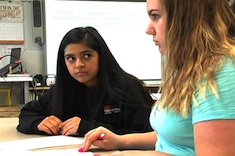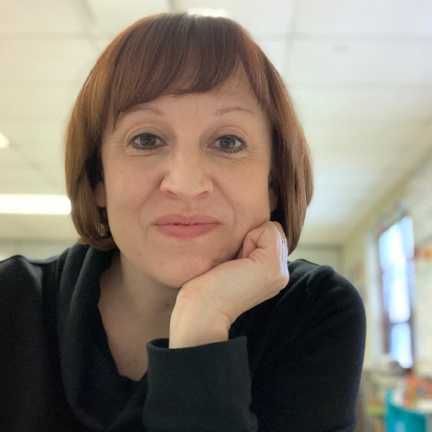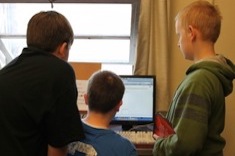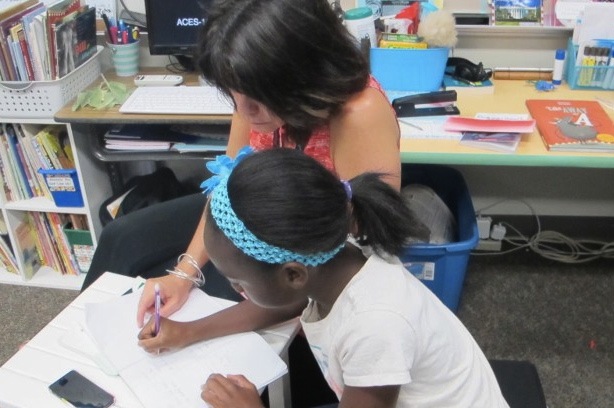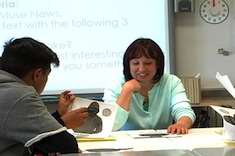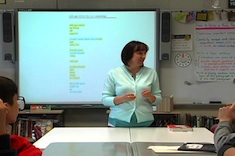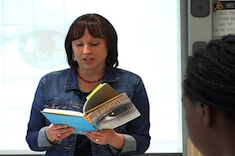“You have this way of buzzing around the room and sprinkling what each student needs right over them,” my administrator once told me in an evaluation conference. It was supposed to be a compliment. But his words lingered. So did the image he had created.
He had painted a picture of a classroom where one person was the expert sprinkler—me. I wasn’t sure I liked that image. I began to think about ways to harness the power of the other experts in the room—the students.
Plus/Delta
For a long time, I have been reading student work with a list in hand—student names are on the left side and a line for comments is on the right. As I go through student drafts, I jot down whatever occurs to me. I try to think of these notes as a plus/delta and mark them as such. The plus denotes strengths the writer has shown in this particular piece. Delta (the Greek letter that looks like a triangle) can be a symbol for change in math and science, so it marks areas in which the writer might have for potential change or growth.
For years, I have used these lists to plan and hold conferences with student writers. I look for patterns to decide how to group students for minilessons. Writers who have similar strengths are likely ready to move on to the same next step. Writers with the same delta are likely in need of the same support. Outliers, who do not fall into any groups, are scheduled for one-on-one conferences where I begin by sharing the plus and teach into the delta.
The lists can also be helpful as a resource at the end of a unit of study, to see how far a writer has come. There is almost always a big shift in what I name as a plus and as a delta on a final paper at the end of a unit of study compared with a first draft at the beginning.
New Use for an Old Tool
Recently, I found a new purpose for my plus/delta lists. After looking at stacks of drafts of literary analysis essays, I had listed pluses for students such as attempted parenthetical citations, thorough evidence, and strong transitions.
I had just finished individual writing conferences for the day, where I had used this list of strengths to name what writers were doing well. I was about to ask students to pack up their belongings for the end of class when I heard Rachel’s desperate plea: “I need help!” I stopped by and inquired further. She was struggling to find a way to transition from one paragraph in her essay to the next.
It occurred to me: not only could I use the strengths of individual students when conferring with them about their own papers, but I could also use the strength of an individual student in a conference with another student. With the list of pluses still in my hand and fresh in my mind, I invited Clarissa to join Rachel and me. Clarissa’s essay was the perfect tool to demonstrate strong transitions, and Clarissa was the perfect expert to sprinkle over Rachel exactly what she needed.
Peer-to-Peer Conferring
I began by restating what Rachel had shared with me—that she needed a transition sentence to connect her second body paragraph to her third—and invited Clarissa to talk about the process she went through to write her transition sentences. You can view our exchange here:

Students were in the midst of working on literary analysis essays on books of their choice, with claims they crafted. Clarissa was writing about You Can’t See the Elephants by Susan Kreller, a story about a young girl named Mascha who makes a drastic choice to try to save her friends from their abusive father. Clarissa’s claim was that rather than helping, Mascha escalates the situation through her thoughts, her actions, and the lies she tells people.
Rachel was writing about Chasing Brooklyn by Lisa Schroeder, which is about a high school girl named Brooklyn whose boyfriend Lucca begins to haunt her after they were involved in a car crash that killed him. Rachel’s claim was that Brooklyn changes as a result of the events of the story. She decided to organize her body paragraphs in a beginning, middle, and end sequence, rather than by subtopic, like Clarissa.
Clarissa and Rachel talking to each other, writer to writer, resulted in Rachel immediately drafting a transition sentence that worked for her paper.
Now when I buzz around the room, I am not the only one sprinkling. I am always keeping in mind the connections I can make between one writer’s delta and another writer’s plus.

